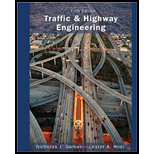
Concept explainers
The fundamental differences between how LOS is determined for the automobile mode compared to human-powered modes.
Explanation of Solution
Introduction:
The level of service is a term that is used to measure the quality of motor vehicle traffic service. The level of service is used for the analysis of roadways and intersection. It categorizes traffic flow and quality of the traffic based on some performance, measures such as traffic density, congestion, and speed.
For the automobile mode, LOS is computed by calculating the level of service at each lane group, intersections, and intersection approach. These are known as a control delay. Control delay is based on the performance measures of the traffic which are determined on the field.
The lane group level of service is calculated by considering both control delay, as well as volume to capacity ratio. But at the intersections, it is calculated only by considering the control delay. Control delay does not represent the consumption of fuel, and the travel time loss.
For the human-powered modes, the LOS is determined by considering the factors that can be described as either performance measures, such as pedestrian delay, and indicator of intersection characteristics as pedestrian corner circulation area, etc.
Conclusion:
Thus, for the automobile mode, LOS is computed by calculating the level of service at each lane group, intersection approach, and at intersections, and for the human-powered modes, the level of service is calculated by considering the pedestrian delay, pedestrian corner circulation area, etc.
Want to see more full solutions like this?
Chapter 10 Solutions
Traffic and Highway Engineering - With Mindtap
- What is the difference, if any, between the critical volume of a phase and the volume of a lane group?arrow_forwardThe larger frontal cross-sectional area of the vehicle, the smaller air resistance true or false?arrow_forwardQUESTION 7 What is the braking distance (ft) when the design speed is 65 mph, assuming the AASHTO recommended deceleration rate and perception-reaction time.arrow_forward
- Consider two cars approaching from the opposite directions at 90 km/h and 60 km/h. If the reaction time is 2.5 s, coefficient of friction is 0.7 and brake efficiency is 50% in both the cases, the minimum sight distance required to avoid a head-on collision will be nearly?arrow_forwardCivil Engineering Q)If the horse power 107.1 hp produced by a passenger car traveling at a speed of 84 mi/h on a straight road of 6% grade with a smooth pavement.(Find the rolling / curve/ air/ grade)resistance ?(Note : Assume the cross-sectional area of the car is 45 ft2)arrow_forward(a) What is Superelevation? Derive a mathematical expression for it?(b) Calculate superelevation for a design speed of 80 km/hr in a curve of radius 100 m with a friction factor of 0.12?(c) Superelevation in horizontal curve of road is responsible for your safety. Explain?arrow_forward
- Consider the following data: Design speed = 96 kmph Speed of overtaken vehicle = 80 kmph Reaction time for overtaking = 2 sec Acceleration = 2.5 kmph/sec The safe overtaking sight distance on a two-way traffic road way be nearlyarrow_forwardin this phase, the driver acquires sufficient information concerning the object or condition Decision phase Identification phase Detection phase Oarrow_forwardQ1- Complete the following sentences: 1) Design Hourly Volume (DHV) can be used for. 2) The unit of Ideal Capacity is 3) When the Level of Service is A, this means the ratio of V/C is 4) The Perception Reaction Time (PRT) has four stages, the last stage is........... 5) The driver should be and- to have a good performance. 6) The Vehicle characteristics for the geometric design Criteria are 7) 8) and- It is total yearly volume divided by the number of days less than a year. -It is the number of vehicles occupying a unit length of a roadway at a given time. 9) The number of lanes in the road depends on traffic volume and 10) The value of Peak Hour Factor (PHF) should always less than:arrow_forward
- Q1) Choose the correct answer.. 1-The first stage in traffic engineering studies is.. A. Traffic volume studies B. Spot speed studies C. Speed and delay studies D. Origin and destination studies 2.For the movement of vehicles at an intersection of two roads, without any interference, the type of grade separator generally preferred to, is A. Partial Cloverleaf B. Trumpet C. Diamond Interchange D. Full Cloverleaf 3. Pick up the incorrect statement from the following.. A. The speed on urban roads 120-130 km/hr. B. There is no control on the urban roads Access. C. The urban roads are use for long distance. D. Level of service for urban roads A and B. 4. The main objective of traffic volume studies.. A. To decide priority for improvement of roads. B. For geometric design. C. For computing roadway capacity. D. To plan traffic operation. 5. The minimum space headway increases with A. Increase in length of vehicle. B. Increase in width of vehicle. C. Increase in weight of vehicle. D. Increase…arrow_forwardCompute the headlight sight distance in meters for a freeway with a design speed of 75 kph. Assume time of perception to be 5 sec. and skid resistance to be 0.60. Use 90% brake efficiency.arrow_forwardThe distance traveled by a moving vehicle during perception and brake reaction time is known as O Sight distance O Stopping distance O Lag distance O Permissible distancearrow_forward
 Traffic and Highway EngineeringCivil EngineeringISBN:9781305156241Author:Garber, Nicholas J.Publisher:Cengage Learning
Traffic and Highway EngineeringCivil EngineeringISBN:9781305156241Author:Garber, Nicholas J.Publisher:Cengage Learning
